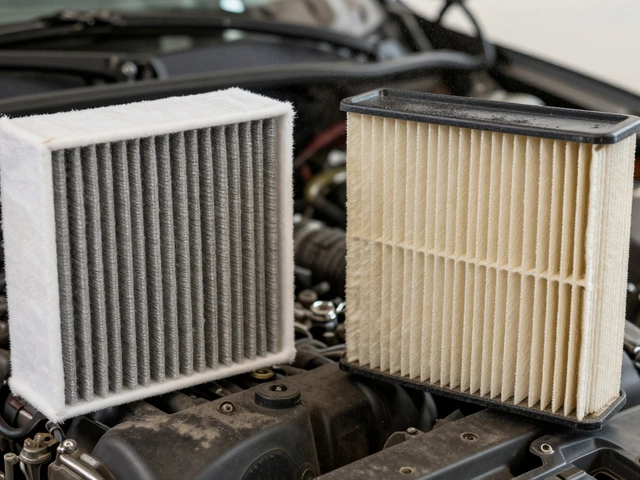K&N air filters have long captured the attention of car enthusiasts looking to boost engine performance. Yet, there's a persistent question on the minds of drivers: do these high-performance filters cause harm to engines? To find some answers, it's key to understand what these filters bring to the table.
K&N air filters promise more airflow and, ultimately, more power, which sounds like music to any gearhead's ears. But like any automotive upgrade, they come with their own set of considerations. A common concern is whether their increased airflow might lead to engine wear or fail to provide adequate filtration. Let's take a closer look at how they work and what you need to keep in mind to ensure your engine stays in top shape.
- Understanding K&N Air Filters
- Benefits of K&N Air Filters
- Potential Problems and Concerns
- Maintenance and Tips
- Expert Opinions and User Experiences
Understanding K&N Air Filters
When diving into the world of K&N air filters, it’s truly fascinating how these devices differ from the typical air filters found in most vehicles. At the core of K&N's design is its innovative use of layered, oiled cotton. Unlike standard paper filters, which can often restrict airflow by design, the oiled cotton allows for excellent filtration while maintaining a high volume of air passage. This unique combination is what attracts performance enthusiasts to consider them for enhancing their vehicles.
The basic construction of K&N air filters involves multiple layers of cotton gauze between sheets of aluminum wire mesh. Each layer of cotton is coated with a slight amount of oil. This oil is crucial because it helps trap dust and other particles, ensuring they don’t reach the engine itself. As such, the sophisticated design promises both increased horsepower and acceleration without sacrificing engine protection. It’s important to note that the performance air filters market shows K&N as a leading brand not just for cars but for a myriad of vehicles, including motorcycles and ATVs, which highlights their widespread application and trust.
"The K&N filter arguably offers the best air-to-fuel ratio you can achieve without intricate tuning," once commented a renowned automotive engineer in a prominent car enthusiast magazine. "It’s really an ingenious piece of kit for those who want just that little bit more out of their engine without going overboard."
The way K&N filters are engineered allows them to sustain optimal airflow, even as they accumulate particles, which is starkly different from traditional options that might clog and restrict air over time. Additionally, their empowerment claim of potentially lasting a million miles under usual driving conditions speaks volumes of their resilience. However, with such promising assertions, it pays to realize that proper maintenance is critical to harness every ounce of purported benefit. Maintenance procedures often emphasize the importance of periodically cleaning and re-oiling the filter to sustain its effectiveness.
Another key aspect is understanding the targeted demographic, particularly among those who refit their existing vehicles without altering the broader mechanical systems. These filters aren't just for racing or high-speed applications. They cater to anyone who wants better performance without investing in overly complicated upgrades. Lastly, the return-on-investment factor, often overlooked but essential, showcases the reusability and longevity of K&N filters when maintained correctly, making them a suitable choice in the long run compared to disposable ones.
Benefits of K&N Air Filters
When it comes to boosting engine performance and getting the most out of your ride, K&N air filters are a popular choice among car enthusiasts. Their roots go back to racing, where maximum airflow becomes crucial. Unlike traditional paper filters, K&N filters use layers of oiled cotton, which is not only more effective for airflow but also reusable. The construction itself allows for improved engine breathability, which can lead to an increase in horsepower. Drivers often notice a distinct improvement in throttle response due to the efficiency in air intake.
One of the standout features of these filters is their longevity. While conventional paper filters need frequent replacements, a K&N air filter is designed to last for the life of your vehicle. This is because they are washable and reusable, a feature that can save a significant amount of money over time. Maintaining them involves a simple cleaning process, which typically needs to be done every 30,000 to 50,000 miles depending on driving conditions. Many see this as a sustainable choice since it reduces waste and limits the environmental impact of constantly discarding paper filters.
Another benefit is the potential improvement in fuel economy. By allowing more air into the engine, the combustion process becomes more efficient, which might reduce fuel consumption. This aspect, combined with its reusability, makes K&N filters appealing to environmentally-conscious drivers. The installation process is straightforward, often requiring no special tools, and it's crafted to fit simply where the stock air filter would be, which makes the upgrade process fairly easy.
Moreover, K&N's innovative technology has been well-acknowledged in the automotive community. To quote renowned auto magazine "Motor Trend":
"K&N Air Filters are a staple among performance enthusiasts, known for providing that crucial breath of fresh air to engines across the racing spectrum."This endorsement highlights why many choose to replace their standard air filters with K&N as a first step toward any performance enhancements.
In terms of specs, some car owners might be interested in understanding the performance metrics. Taking a look at airflow capacity, tests have demonstrated that these filters can achieve up to 50% more airflow compared to standard paper filters. For those focused on numbers, this is a compelling statistic. Additionally, the enhanced filtration technology doesn’t compromise on protecting the engine from contaminants, balancing both increased airflow and clean air intake.

Potential Problems and Concerns
While K&N air filters have garnered a loyal following for their performance-enhancing capabilities, they're not without their share of potential drawbacks. One noteworthy concern centers around the level of filtration these air filters provide. Designed to allow maximum airflow into the engine, K&N filters use an oil-treated cotton gauze as their primary filtering medium. This can effectively trap dust and debris, but some critics argue that the filtering capacity might not match up to traditional paper filters. In environments where airborne particles are particularly abundant, like dusty roads or off-road trails, this could potentially lead to more particles reaching the engine, which can cause wear over time.
Another point to consider is the oiled nature of K&N filters. The oil applied to the cotton gauze is crucial for trapping particles. However, applying too much oil during maintenance can have adverse effects. Excess oil can infiltrate the vehicle's air intake system, possibly leading to oil accumulation on the mass airflow sensor. This complication can trigger check engine lights or affect sensor readings, thus impacting fuel economy and engine performance. It’s essential for users to carefully read the guidelines and perhaps even watch tutorials to ensure they're applying just the right amount of oil.
Moreover, maintaining these performance air filters requires more diligence than many might anticipate. While disposable paper filters can simply be replaced when dirty, a K&N filter requires cleaning and re-oiling periodically to maintain its benefits. This additional upkeep can be cumbersome for those not accustomed to such maintenance. However, one could argue this effort is worthwhile for the potential gains in horsepower and throttle response. A vehicle enthusiast named Alex noted in a car forum discussion, "After switching to a K&N, I did notice better throttle response, but the extra steps in cleaning and oiling – it’s a love-hate relationship."
Temperature conditions can also influence how these air filters perform. In colder climates, moisture can build upon the filter, potentially leading to the formation of ice, which restricts airflow. This, however, is not a frequent issue, but it’s something to be mindful of for those living in regions with harsh winters. Additionally, it’s worth considering the initial cost of K&N air filters which tends to be higher compared to standard paper filters. Although they are marketed as long-lasting, which theoretically offsets their higher upfront cost, some car owners might find the initial investment not as convincing.
In assessing these potential concerns, it’s important to weigh them against the specific needs and conditions in which the vehicle is operated. While the allure of increased engine performance is strong, understanding the right application and consistent maintenance is key. This balance will ensure these performance air filters work effectively without compromising the longevity of your engine. When properly maintained, K&N air filters can be a reliable upgrade, but they require a bit of dedication on the part of the owner to justify their prowess.
Maintenance and Tips
Maintaining K&N air filters properly is essential to ensure they deliver the promised performance benefits without causing any damage to your engine. Unlike paper filters, K&N filters are reusable and designed to last for the lifetime of your vehicle, provided they are cleaned and oiled properly. To start, you should check the condition of your air filter periodically, especially if you drive on dusty roads or in areas with high pollution. Regular inspections will help you determine when it's time to clean the filter.
Cleaning a K&N air filter is relatively straightforward, but it's important to use the right methods to avoid damaging the delicate cotton gauze. Typically, every 50,000 miles is a good guideline for cleaning, but for severe driving conditions, you might need to do it sooner. To clean the filter, you'll need a special K&N cleaning kit which includes a cleaner and oil. First, remove the filter and spray it thoroughly with the cleaner, let it sit for about ten minutes to loosen the dirt. After this, rinse the filter with low-pressure water, always from the clean side to the dirty side to avoid embedding dirt.
Once the filter is rinsed, let it dry naturally. A crucial step is re-oiling the filter because the oil is what catches the dirt particles, preventing them from entering your engine. Make sure to apply just enough oil to coat the gauze, as too much oil can cause issues with the vehicle's mass airflow sensor. Oil from the air filter can blow onto the sensor, leading to poor engine performance. According to an article by Car Maintenance Magazine, improper maintenance is often a root cause of issues with performance air filters, emphasizing the need for careful handling of these components.
K&N's official recommendations are a reliable guideline: 'Always follow the instructions provided with your cleaning kit. Avoid using anything other than K&N products, as different oils or cleaners could diminish performance or damage the filter.'
To help you keep track of your maintenance schedule, some enthusiasts suggest keeping a log or mark important miles in your calendar. The process of cleaning and re-oiling should be done in a clean, well-lit area to ensure no debris falls into the filter. Remember, a well-maintained filter not only performs better but can save you money in the long run by improving fuel efficiency.
It's worth noting that some users have reported oil contamination issues. Using a light touch when reapplying oil can mitigate many of these problems. Additionally, there are a few changes in vehicle performance dynamics when using a K&N filter, specifically around throttle response and sound. Paying close attention to these subtle changes can offer clues about when your filter needs attention. In essence, consistent and careful maintenance will allow you to enjoy the benefits of K&N air filters without the drawbacks people worry about.

Expert Opinions and User Experiences
The conversation about K&N air filters and potential engine performance issues isn't complete without diving into the realm of expert analysis and the voices of those who have real-world experience. In automotive circles, these filters are often a topic of heated debate, with some experts applauding their design while others approach them with caution. Their high-flow design is engineered to improve engine performance by allowing more air into the combustion chamber. This is where the love story begins for many car enthusiasts eager to smuggle in a few more horsepower.
Mechanics and automotive experts, however, offer a slightly more nuanced view. While they generally agree that the increase in airflow can translate to better performance, they also highlight potential issues. One frequent point of discussion is the filter's ability to effectively keep out harmful contaminants. Concerns arise from the notion that increased airflow might result in reduced filtration efficiency, potentially allowing more dust and dirt to enter the engine.
"The trade-off with high-flow air filters is always the balance between performance gain and debris lodging in the engine," noted an article in 'Auto Technica Magazine'.It becomes evident that while K&N filters offer worthwhile benefits, they also require timely maintenance to counterbalance any potential drawbacks.
Real users, ranging from daily drivers to weekend racers, share both positive and challenging experiences. Many report noticeable improvements in throttle response and overall driving sensation, especially in cases where the previous filter was overly restrictive. Enthusiastic testimonials often describe a new, freer engine sound and a slight bump in mileage—sometimes a welcome surprise. Yet, not all feedback is glowing. Some users mention they haven't seen any significant differences, while a small number express worries about the long-term effects related to filtration. A fraction have experienced instances of the filters becoming excessively oiled, cautioning others that improper installation is commonly to blame, rather than the filter itself.
The key takeaway from both experts and users revolves around proper maintenance and understanding what to expect from a K&N air filter. Many agree that the filters are not a cure-all solution but, rather, a part of an overall performance strategy. Loyalty to regular cleaning schedules and correct installation often dictates whether the filter will work as a gift or a curse. This dual nature makes it essential to pair them with a relevant understanding of vehicle requirements, which savvy motorists consider crucial.
There's no sweeping consensus whether K&N air filters will universally cause problems, as their impact largely depends on a vehicle's unique needs and how the filters are handled. Despite the varied experiences and expert opinions, what becomes clear is that with mindful upkeep and correct usage, these filters can be a valuable component in improving engine dynamics. As the dialogue continues, both experts and enthusiasts contribute their voices, shaping a vibrant discussion around the roles these filters play under the hood.






